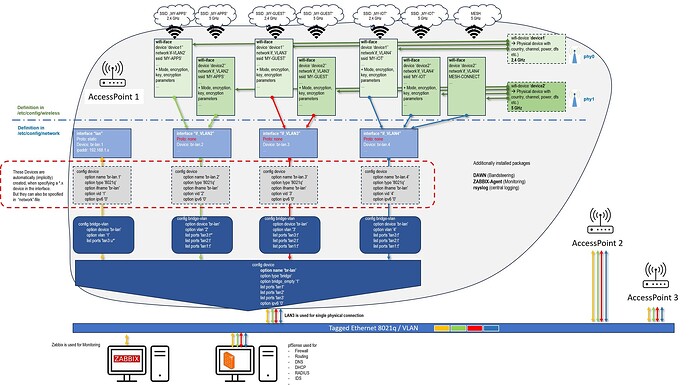Hi, I’m running OpenWrt since many years on different devices. (tp-link, totolink, d-link) I configure separate SSIDs for Home-, Guest- and IOT-usage and assigned them to different VLANS. Everything works fine with the “mtk-bpi-r4-MT76-SD-20240202.img” provided in the “OpenWRT MTK MP3.1 wifi SDK or MT76 wifi driver for BE14000 Wifi Card”. (https://wiki.banana-pi.org/Banana_Pi_BPI-R4#Release_image)
BUT: it is not working neither with “OpenWRT MTK MP3.1 wifi SDK” nor with “OpenWRT MTK MP4.0 wifi SDK wifi driver for BE14000 Wifi Card”
As soon as I enable VLAN-Filtering on the “br-lan” Bridge, Authentication with the WiFi is not possible anymore. When I try to connect with an iPhone for example, it shows: “Invalid password for AP_MTK_MT7990_2G_2” Neither password I’m entering is accepted anymore. No link possible. This is true for all types of encryption. Tested wpa2, psk2ccmp, sae…
Here is what I can do to reproduce. (based on SDK40-sd-image)
- Flashed new sd image (mtk-bpi-r4-SD-20240620.img) on empty SD card
- Tested unencrypted connection to “AP_MTK_MT7990_2G_2” : works

- changed to encrypted
#/etc/config/wireless
config wifi-iface 'ra1'
option device 'MT7990_1_1'
option network 'lan'
option mode 'ap'
option disabled '0'
option ssid 'AP_MTK_MT7990_2G_2'
option encryption 'none'
...
# -->>
option encryption 'sae'
option key '12345678' (example)
...
Test: connection works with encryption ![]()
- added VLAN added VLAN-Filtering to br-lan bridge, assigned lan-Interface to
#/etc/config/network
# <-- old
config device
option name 'br-lan'
option type 'bridge'
list ports 'lan1'
list ports 'lan2'
list ports 'lan3'
list ports 'eth1'
config interface 'lan'
option device 'br-lan'
option proto 'static'
option ipaddr '192.168.1.1'
option netmask '255.255.255.0'
option ip6assign '60'
# --> new
config device
option name 'br-lan'
option type 'bridge'
list ports 'lan1'
list ports 'lan2'
list ports 'lan3'
list ports 'eth1'
config interface 'lan'
option device 'br-lan.1'
option proto 'static'
option ipaddr '192.168.1.1'
option netmask '255.255.255.0'
option ip6assign '60'
config bridge-vlan
option device 'br-lan'
option vlan '1'
list ports 'lan1:t'
list ports 'lan3:u*'
--- optional: (implicitely created)
config device
option name 'br-lan.1'
option type '8021q'
option ifname 'br-lan'
option vid '1'
option ipv6 '0'
Afterwards VLAN is working (can use tagged frames on LAN1 and untagged on LAN3 for example), but authentication is not working anymore. ![]()
When I switch off encryption (option encryption ‘none’) - wifi-connection is established.
But I’d like to avoid unencrypted communication ![]()
Any ideas? It seems to be a bug in MTK-Driver, since same setting for encryption and VLAN is working with mt76-Driver on same old OpenWrt (OpenWrt 21.02-SNAPSHOT) provided by MTK in their download.
